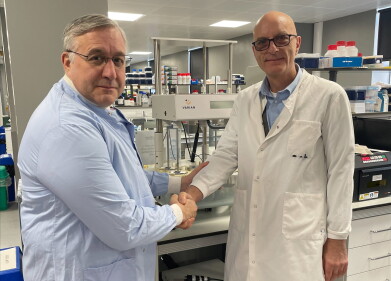News
ALICE to Spark Breakthrough in Cell Biology and Cancer Research
Oct 04 2011
Scientists from the University of Liverpool are linking up to Europe’s most intense terahertz light source – the ALICE accelerator at the Science and Technology Facilities Council’s (STFC) Daresbury Laboratory (UK), to understand the effects of terahertz (THz) rays on human cells and improve our knowledge of disease function.
Professor Weightman, Principal Investigator from the University of Liverpool, explained: “Like radio waves and visible light, THz rays are not expected to damage tissue like X-rays do. Our preliminary research at STFC Daresbury Laboratory has indicated that at low powers human cells appear to be unaffected by THz rays. However,
the research carried out in this unique facility is the only way of establishing the safe limits of human exposure to THz radiation at high powers and what effect repeated low level exposure may or may not have on our bodies.
“The work will give us invaluable insight into the mechanisms of biological organisation and enable us to test a controversial theory of the mechanism by which biological systems organise themselves. This improved understanding of human cells could lead to significant advances in the diagnosis of diseases such as melanomas
and oesophageal cancer. Low power THz instruments are already used to analyse tissue removed in surgery because cancerous and healthy tissue respond differently to THz radiation. The research on ALICE will enable us to greatly improve these procedures and eventually lead to the development of improved low cost instruments for cancer diagnosis, although it is expected to be several years before these developments are realised.”
Dr Mark Surman, a research scientist at STFC Daresbury Laboratory added: “With ALICE we have an opportunity to irradiate living cells in a way that has never been done before, combining a high power source with a tissue culture facility. During Professor Weightman’s research we expect to see about 70 kW of peak power in short
pulses repeated tens of thousands of times every second. This means that the peak power will be thousands of times higher than other laboratory sources. Until now, ultra-high THz power sources have not been available to carry out this kind of research, so it is a major step forward that these trials on tiny samples of human tissue can now be carried out at ALICE.”
Digital Edition
Lab Asia 32.2 April
April 2025
Chromatography Articles - Effects of small deviations in flow rate on GPC/SEC results Mass Spectrometry & Spectroscopy Articles - Waiting for the present to catch up to the future: A bette...
View all digital editions
Events
Apr 09 2025 Tokyo, Japan
Apr 22 2025 Hammamet, Tunisia
Apr 22 2025 Kintex, South Korea
Analytica Anacon India & IndiaLabExpo
Apr 23 2025 Mumbai, India
Apr 23 2025 Moscow, Russia



















